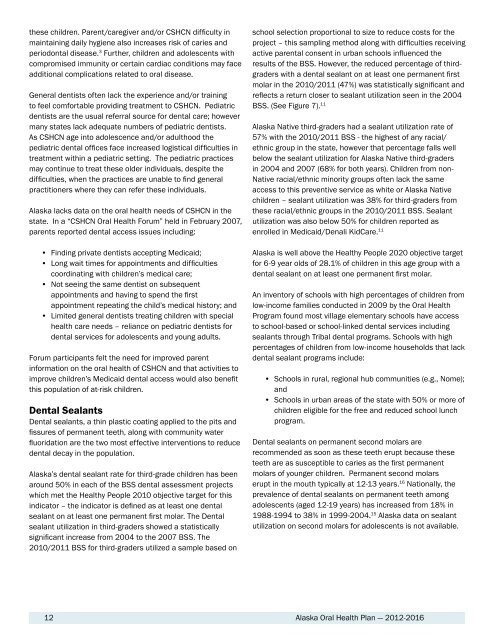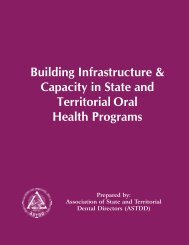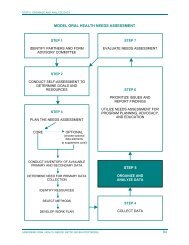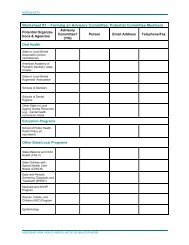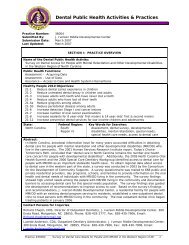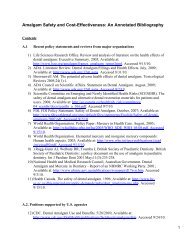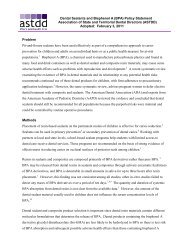AlAskA OrAl HeAltH PlAn - Alaska Department of Health and Social ...
AlAskA OrAl HeAltH PlAn - Alaska Department of Health and Social ...
AlAskA OrAl HeAltH PlAn - Alaska Department of Health and Social ...
You also want an ePaper? Increase the reach of your titles
YUMPU automatically turns print PDFs into web optimized ePapers that Google loves.
these children. Parent/caregiver <strong>and</strong>/or CSHCN difficulty in<br />
maintaining daily hygiene also increases risk <strong>of</strong> caries <strong>and</strong><br />
periodontal disease. 3 Further, children <strong>and</strong> adolescents with<br />
compromised immunity or certain cardiac conditions may face<br />
additional complications related to oral disease.<br />
General dentists <strong>of</strong>ten lack the experience <strong>and</strong>/or training<br />
to feel comfortable providing treatment to CSHCN. Pediatric<br />
dentists are the usual referral source for dental care; however<br />
many states lack adequate numbers <strong>of</strong> pediatric dentists.<br />
As CSHCN age into adolescence <strong>and</strong>/or adulthood the<br />
pediatric dental <strong>of</strong>fices face increased logistical difficulties in<br />
treatment within a pediatric setting. The pediatric practices<br />
may continue to treat these older individuals, despite the<br />
difficulties, when the practices are unable to find general<br />
practitioners where they can refer these individuals.<br />
<strong>Alaska</strong> lacks data on the oral health needs <strong>of</strong> CSHCN in the<br />
state. In a “CSHCN Oral <strong>Health</strong> Forum” held in February 2007,<br />
parents reported dental access issues including:<br />
• Finding private dentists accepting Medicaid;<br />
• Long wait times for appointments <strong>and</strong> difficulties<br />
coordinating with children’s medical care;<br />
• Not seeing the same dentist on subsequent<br />
appointments <strong>and</strong> having to spend the first<br />
appointment repeating the child’s medical history; <strong>and</strong><br />
• Limited general dentists treating children with special<br />
health care needs – reliance on pediatric dentists for<br />
dental services for adolescents <strong>and</strong> young adults.<br />
Forum participants felt the need for improved parent<br />
information on the oral health <strong>of</strong> CSHCN <strong>and</strong> that activities to<br />
improve children’s Medicaid dental access would also benefit<br />
this population <strong>of</strong> at-risk children.<br />
Dental Sealants<br />
Dental sealants, a thin plastic coating applied to the pits <strong>and</strong><br />
fissures <strong>of</strong> permanent teeth, along with community water<br />
fluoridation are the two most effective interventions to reduce<br />
dental decay in the population.<br />
<strong>Alaska</strong>’s dental sealant rate for third-grade children has been<br />
around 50% in each <strong>of</strong> the BSS dental assessment projects<br />
which met the <strong>Health</strong>y People 2010 objective target for this<br />
indicator – the indicator is defined as at least one dental<br />
sealant on at least one permanent first molar. The Dental<br />
sealant utilization in third-graders showed a statistically<br />
significant increase from 2004 to the 2007 BSS. The<br />
2010/2011 BSS for third-graders utilized a sample based on<br />
school selection proportional to size to reduce costs for the<br />
project – this sampling method along with difficulties receiving<br />
active parental consent in urban schools influenced the<br />
results <strong>of</strong> the BSS. However, the reduced percentage <strong>of</strong> thirdgraders<br />
with a dental sealant on at least one permanent first<br />
molar in the 2010/2011 (47%) was statistically significant <strong>and</strong><br />
reflects a return closer to sealant utilization seen in the 2004<br />
BSS. (See Figure 7). 11<br />
<strong>Alaska</strong> Native third-graders had a sealant utilization rate <strong>of</strong><br />
57% with the 2010/2011 BSS - the highest <strong>of</strong> any racial/<br />
ethnic group in the state, however that percentage falls well<br />
below the sealant utilization for <strong>Alaska</strong> Native third-graders<br />
in 2004 <strong>and</strong> 2007 (68% for both years). Children from non-<br />
Native racial/ethnic minority groups <strong>of</strong>ten lack the same<br />
access to this preventive service as white or <strong>Alaska</strong> Native<br />
children – sealant utilization was 38% for third-graders from<br />
these racial/ethnic groups in the 2010/2011 BSS. Sealant<br />
utilization was also below 50% for children reported as<br />
enrolled in Medicaid/Denali KidCare. 11<br />
<strong>Alaska</strong> is well above the <strong>Health</strong>y People 2020 objective target<br />
for 6-9 year olds <strong>of</strong> 28.1% <strong>of</strong> children in this age group with a<br />
dental sealant on at least one permanent first molar.<br />
An inventory <strong>of</strong> schools with high percentages <strong>of</strong> children from<br />
low-income families conducted in 2009 by the Oral <strong>Health</strong><br />
Program found most village elementary schools have access<br />
to school-based or school-linked dental services including<br />
sealants through Tribal dental programs. Schools with high<br />
percentages <strong>of</strong> children from low-income households that lack<br />
dental sealant programs include:<br />
• Schools in rural, regional hub communities (e.g., Nome);<br />
<strong>and</strong><br />
• Schools in urban areas <strong>of</strong> the state with 50% or more <strong>of</strong><br />
children eligible for the free <strong>and</strong> reduced school lunch<br />
program.<br />
Dental sealants on permanent second molars are<br />
recommended as soon as these teeth erupt because these<br />
teeth are as susceptible to caries as the first permanent<br />
molars <strong>of</strong> younger children. Permanent second molars<br />
erupt in the mouth typically at 12-13 years. 16 Nationally, the<br />
prevalence <strong>of</strong> dental sealants on permanent teeth among<br />
adolescents (aged 12-19 years) has increased from 18% in<br />
1988-1994 to 38% in 1999-2004. 15 <strong>Alaska</strong> data on sealant<br />
utilization on second molars for adolescents is not available.<br />
12 <strong>Alaska</strong> Oral <strong>Health</strong> Plan — 2012-2016


